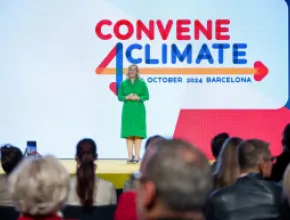What’s new in green or sustainable meetings? This is most certainly the No. 1 question I have been asked over the past year.
We humans are so trained to look for the new, fresh, latest trends in everything we do and this is no exception. Sustainable meetings have been around a while, and now we are anxious to be finished implementing policies, check it off our list and move on to something more exciting.
It might help to think of sustainability in the hospitality industry as a large ship. It doesn’t turn on a dime, and it takes a while to make a mid-course correction a few degrees at a time. Sometimes you just need to keep your hands on the rudder and keep making incremental changes. Not as exciting, I know.
With that said, there are some areas of green events that are on the forefront of this course correction today:
Measurement. This next step is finally taking hold. No longer can event organizers and venues say they are “green” without the data to back it up. I was happily surprised at how many of the session presenters at the GMIC Sustainable Meetings Conference in Montreal had slides full of facts and figures to back up their claims. These facts and figures also prove the business case for environmental responsibility by showing the economic savings and making it easier to sell to key stakeholders.
Measurement also appears to be a precursor to the adoption of standards for most organizations as they get a baseline of their environmental impact. (See the article in next month’s issue featuring an in-depth story on measurement.)PageBreak
Social Responsibility. The industry is readily adopting the notion of some type of CSR project during a conference or event. This is definitely the first step toward social advocacy for meetings. Its popularity can be linked directly to the “look good, feel good, team-building” opportunities it presents. These projects can take place before, during or after your meeting and include anything from planting trees to working at a food bank to raising money for a nonprofit organization.
It is important to link your legacy project to something meaningful either for the organization or for participants. One of my favorite events was having a conference of computer engineers volunteer to write programs for school children in a low-income school district while the students looked on.
Local, Sustainable Food. Everyone wants to eat better. Guests are asking for healthier, fresher food, driving this aspect for conferences and events. Participants are no longer satisfied with anything less, even when on the road. Collaborating with the chef to source from local growers and sustainable suppliers ensures that will happen. Make sure you also inform participants where the food comes from with cards on the menu or buffet line. If it is organic, tell them so. You are educating them and looking good all at the same time.PageBreak
Vendors Are Making It Easier. Hotels, convention centers, general service contractors and others are really stepping up to be more sustainable.
Five years ago, it was tough to find one of these suppliers with an environmental policy much less a product. Not so today. For them it is a competitive advantage, for planners, a welcome relief. Hint: If you start with a sustainable destination or city, your planning will become much easier. These destinations already have energy-efficient meeting venues, green hotels, walkable communities, mass transit, recycling and environmentally responsible vendors. Start by asking the CVB if they are a green destination and request a list of sustainable vendors during the site selection process.
What’s New May Be That It’s Not New. No longer just a trend, being sustainable is slipping into the mainstream. The public requires organizations to be good citizens and to display that at meetings.
Nowhere else is this more visible than at a gathering of your key stakeholders, and others will hear about it—guaranteed. If you aren’t constantly monitoring social media during your events to find out how your corporate image is coming across, you should be.
So, stay the course and continue making changes, even if it isn’t the latest “shiny bauble.” The latest “shiny bauble,” hybrid meetings, definitely has its roots in sustainability by requiring less travel, increased use of technology, and offering a new way to connect your attendees. Savvy professionals know both of these are here to stay and are embracing, not avoiding, the tools to keep relevant in today’s meetings market.
 Nancy J. Zavada (Twtter: @nancyjzavada), CMP, is a leader, innovator and entrepreneur in the meeting planning and events industry and is a principal with MeetGreen, a Portland, Ore.-based conference management and consulting firm that she founded and which specializes in green meetings. Zavada is cofounder of the Green Meeting Industry Council, and is also the coauthor of Saving Green by Going Green, available at www.meetgreen.com. Her blog, “Pretentious Musings of a Meet Green Martyr,” shares resources, tips, ideas and funny stories about the life of a green meeting planner, and can be accessed at http://blog.meetgreen.com. To enquire about purchasing a checklist and other tools for planning a green meeting, contact MeetGreen at info@meetgreen.com.
Nancy J. Zavada (Twtter: @nancyjzavada), CMP, is a leader, innovator and entrepreneur in the meeting planning and events industry and is a principal with MeetGreen, a Portland, Ore.-based conference management and consulting firm that she founded and which specializes in green meetings. Zavada is cofounder of the Green Meeting Industry Council, and is also the coauthor of Saving Green by Going Green, available at www.meetgreen.com. Her blog, “Pretentious Musings of a Meet Green Martyr,” shares resources, tips, ideas and funny stories about the life of a green meeting planner, and can be accessed at http://blog.meetgreen.com. To enquire about purchasing a checklist and other tools for planning a green meeting, contact MeetGreen at info@meetgreen.com.







